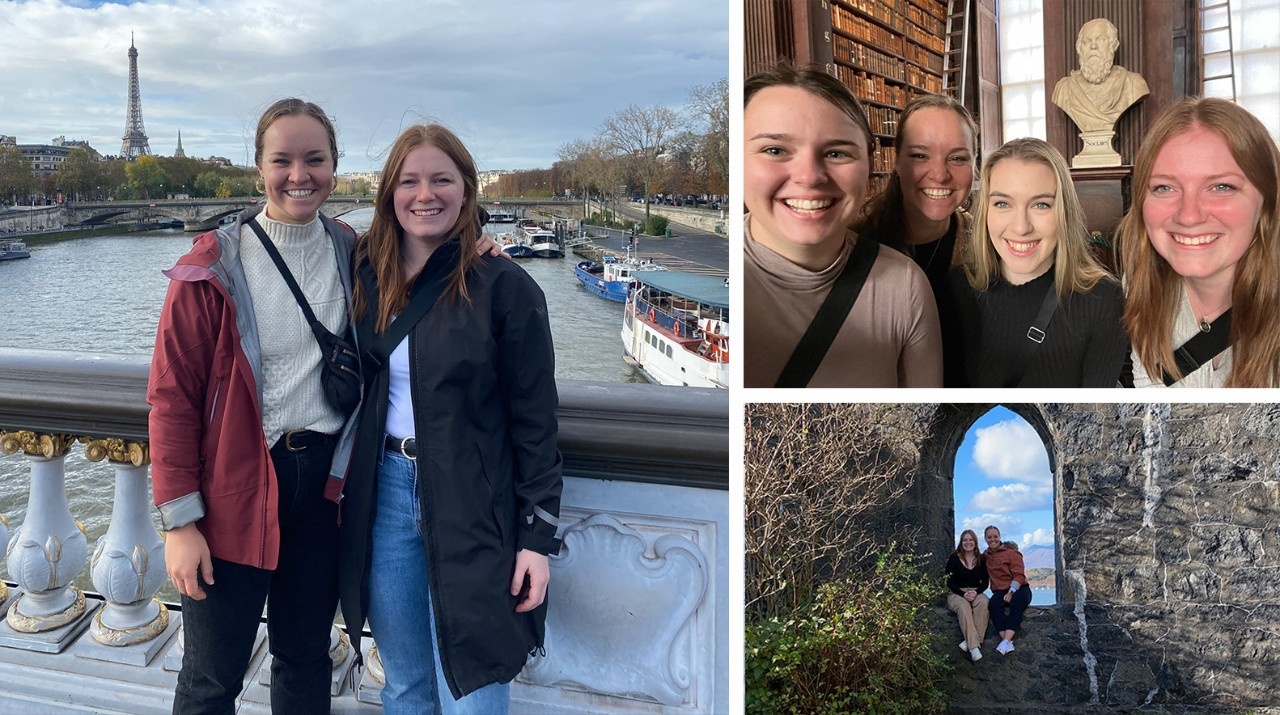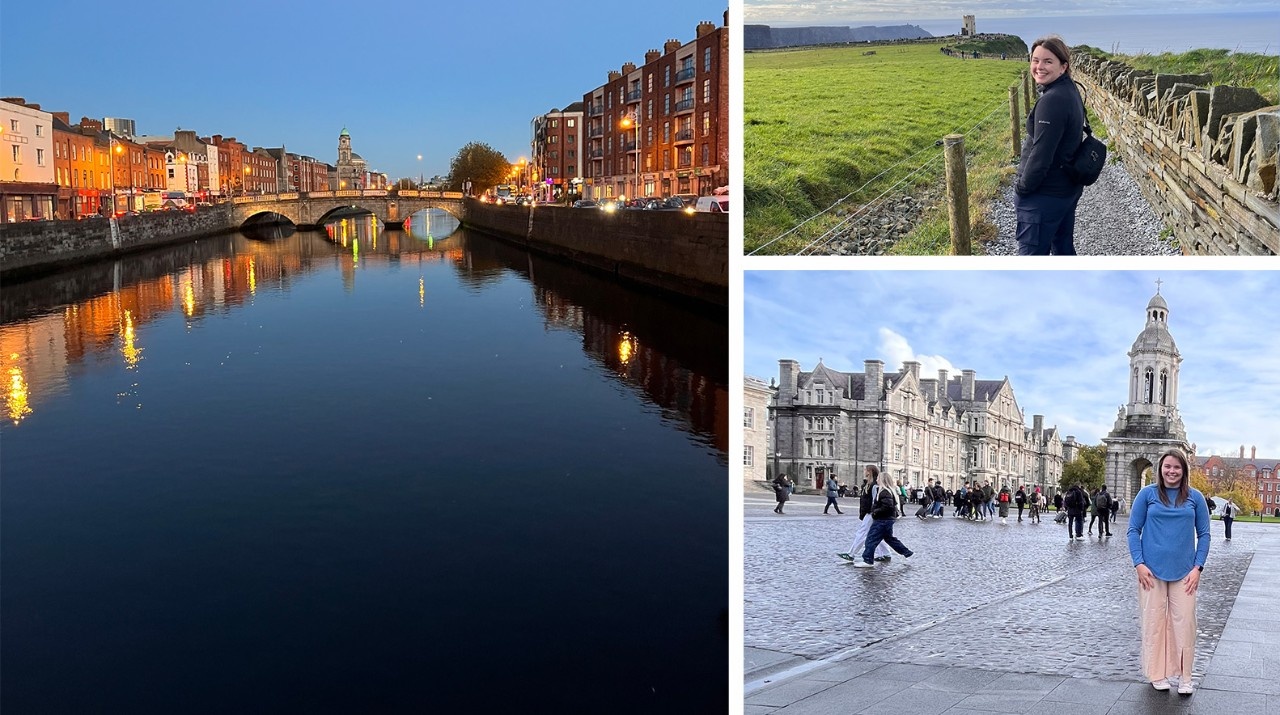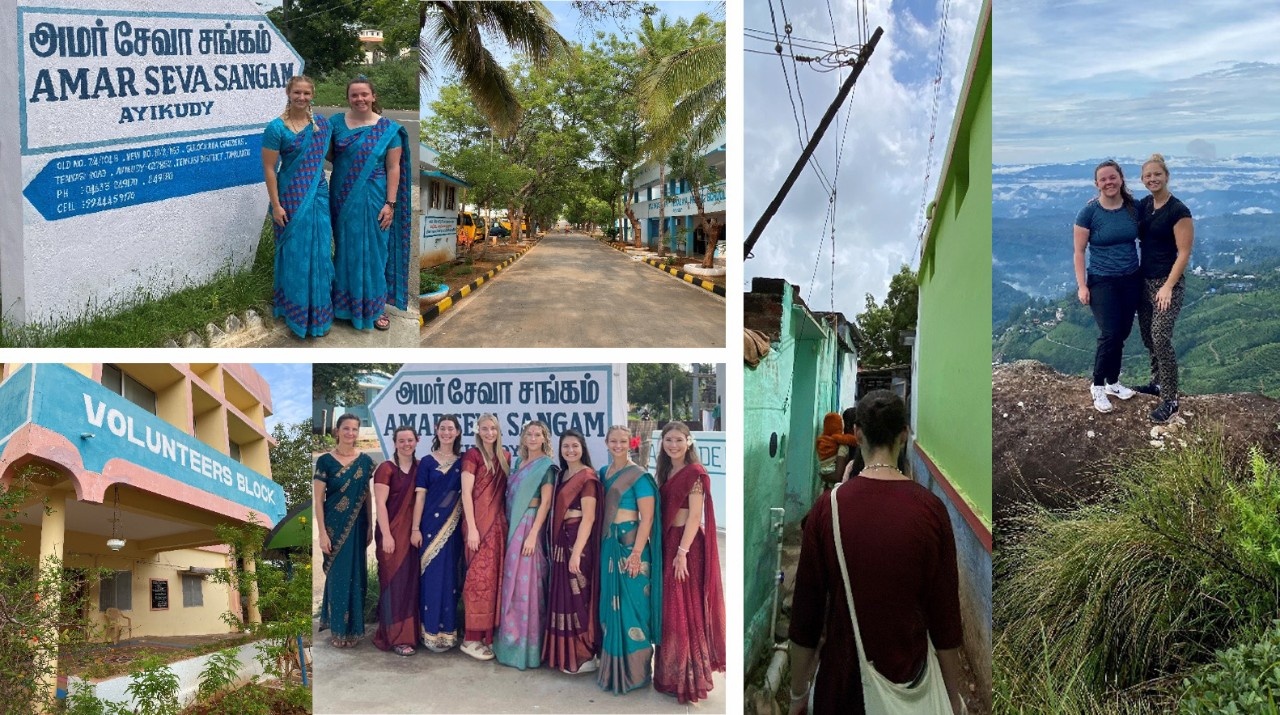Clinical Placements 2023
Clinical placements provide for the integration and application of learning in a clinical environment. This leads to the development of essential competencies for entry to practice in the profession.
The School has professional connections in Ireland, Scotland, Norway and India where eligible students can go on clinical placements. Read about student experiences as they learn about physiotherapy skills and processes from another cultural perspective.

Left: Jennifer Roberts & Hillary Yuill in Norway. Middle: Night view of facility, town and surrounding mountains during a show of northern lights. Right: Day view of the facility, town and surrounding mountains while sledding on the bunny hill with a group of children. Photo Credit: Jennifer Roberts
Internation Clinical Placement Experience: Norway
By Jennifer Roberts and Hillary Yuill
This placement was a really fun experience, and we had the opportunity to meet many other students studying various health disciplines from other European countries and local Norwegian students. The facility is in a remote mountain village, but there were so many amazing opportunities to be active and have fun that the weeks flew by. This facility was as interesting and differed greatly from the facilities at home. It was a non-traditional physiotherapy setting that offered adaptations for everyone to get involved in many indoor, summer, and winter activities. We saw conditions like Down syndrome, Cerebral Palsy, DMD, SMA, Giant Axonal Neuropathy, Wolfe-Hirschhorn Syndrome, and more. Given the time of year, we saw cycling, skiing, horseback riding, and gym games like handball, basketball, volleyball, and floor hockey. We saw the use of sit skis, tandem bicycles, all-terrain wheelchairs, volt hockey wheelchairs, adaptive saddles for horseback riding, and more. They also brought many participants back more than once so they could learn both summer and winter sports to keep participants physically active all year round or to bring them back to learn new skills for progressive and/or lifelong conditions.
There is a language barrier – most adults speak English, but not all children do, so it was often challenging to communicate as we were paired with children’s groups. We relied on some key Norwegian words we picked up, body language, and hand gestures to engage with the kids, but we still had a lot of fun and learned a lot. We got to practice hydrotherapy and exercise prescription through play, which was a really special way to end our journey, and we will take the lessons we learned there and the things we experienced with us through the rest of our lives and physiotherapy careers.

International Clinical Placement Experience: Scotland
By Christine Barnes and Elyse Ferguson
Our placement in Glasgow, Scotland has been a great experience both in and out of the hospital. It has been an incredible learning opportunity, from meeting the rehab team and our Clinical Instructors to developing our individual caseloads over the last few weeks. The responsibilities and role of physio on a rehab unit are very similar between Canada and Scotland; however, we have noticed a few differences, including a greater role of physios in cardiorespiratory management, differences in gait aids, and the use of different terms for familiar equipment. Working in a neuro rehab unit has introduced us to various conditions neither of us had seen before, like GBS, nutritional neuropathy, and Cauda Equina, to name a few. This has increased our clinical expertise and has allowed us unique opportunities to practice clinical reasoning and gain experience working with patients with novel conditions.
Outside of placement, we have been keen to explore as much as possible and had an amazing time being able to visit new cities and countries. We approached each weekend as an opportunity to explore a new location, starting with Glasgow, Scotland, the first weekend in Dublin, Ireland, the following weekend in Paris, France, and then London, England. Being able to travel on the weekends allowed us to gain a better understanding of the culture and the people in each area. Being on placement gave us a better approach to these travel experiences from a physiotherapy and overall health-focused perspective. In Dublin, we met up with Hannah Peters and Taylor Carr-Babineau. We had the opportunity to explore the city together and connect regarding our individual placement experiences in different locations.
The opportunity for learning, self-growth, and professional development has been unmatched, and the experience, although not without minor challenges, was an amazing time. The stories we could share are endless, and we will cherish our time in Scotland long after our return.

International Clinical Placement Experience: Ireland
By Taylor Carr-Babineau
My final clinical placement occurred in the orthopaedic outpatient department at the South Infirmary Victoria University Hospital in Cork City, Ireland. Within the department, I had the privilege of treating patients with a variety of orthopaedic injuries and surgical procedures, including but not limited to; ulnar and radial fractures, humeral fractures, vertebral fractures, neck of femur fractures, multi traumas, fibula and tibia fractures, metacarpal fractures, metatarsal fractures, total knee replacements, total hip replacements, and so much more. This placement was incredibly unique in the vast array of patients I was privy to treating and the uniqueness of each of my patients. This placement challenged me academically, allowing me to learn new assessment and treatment techniques, further develop my clinical reasoning skills, expand my physiotherapy knowledge, and grow exponentially as a physiotherapist and, most importantly, an individual.
The clinical instructors and all the department's physiotherapists were remarkably kind and open, allowing me to continue to learn and grow each day. There was always someone willing to help, whether it be within treatment sessions or following treatment sessions. There was ample learning opportunity, but most importantly, ample opportunity to learn from an array of physiotherapists, each with their approaches, expertise, and views. Learning opportunities where you can learn from not one, not two, but multiple physiotherapists are irreplaceable.
This placement provided countless remarkable opportunities to grow and learn as professionals and people. Cork City, our patients, department members, hospital staff, and Ireland were beyond welcoming. This country, these people, our patients, clinical instructors, other physiotherapists, and physiotherapy assistants made this placement something to write home about and something difficult to leave. I wouldn't change the experience, the opportunity, the people, or any part of it for the world. I strongly believe that this was the most impactful placement I had the opportunity to take part in.
International Clinical Placement Experience: India
By Devyn Manderscheid

Photos: Top left: Devyn and Stephanie wearing ASSA work sarees. Bottom Left:: "volunteer block" is where students lived for 5 weeks. Middle top: Beautiful road Devyn and Stephanie walked along each day. Middle Bottom: Devyn and other Canadians wearing Diwali sarees. Right: narrow streets on community physio visits. Far right: Devyn and Stephanie on the beautiful mountains in Munnar.
For my fifth and final physiotherapy placement, I had the privilege of completing it as an international placement in rural India. It was a neuro placement where I had the opportunity to work with inpatient and outpatient stroke patients and inpatient spinal cord patients, as well as participate in a community physiotherapy day, going around to see various children in their homes. The conditions I saw on community day were spinal muscular atrophy, an undiagnosed MSK disorder, and hypomyelination muscular dystrophy.
I enjoyed the problem-solving I was able to do on the placement and the independence I was given. I had my patients, where I did assessments, outcome measures, and treatment plans. Some outcome measures I did included a wheelchair skills assessment, Spinal Cord Independence Measure, Berg Balance Test, and Chedoke test. Some additional tasks I completed independently were prescribing orthotics, discussing increasing medication prescriptions for my patients and collaborating with OTs as well as OT and PT students.
One of the biggest things I learned on this placement was how to communicate with individuals when there was a language barrier present. Sometimes, I worked with patients using a translator; sometimes, a family member could assist. Sometimes, the patients could get by with enough English; sometimes, the patients spoke a different language, and we used hand gestures and visual demonstrations. This initially frustrated me because I wasn't sure how to get my point across, but I soon learned that facial expressions and excitement are universal. Suppose a patient can complete facilitated dorsiflexion for the first time, and I get excited and enthusiastic. In that case, the patient can see and feel that, and they get excited, too. Building rapport with the patients was much easier than I initially thought.
Some additional things on this placement that I enjoyed was getting to know and collaborate with the PT students from northern India who were also here on placement. We shared cultural celebrations by having a Halloween movie and candy night with them, and they showed us special dances for festivals. We also learned from each other in the clinical setting because we watched five presentations from the Indian students during placement, including case study and gait analysis presentations.
They also learned from us by viewing a presentation on ulcer prevention I developed in collaboration with fellow Dal PT student Stephanie Cairns, and by reviewing personalized printouts, we provided about stroke patients on proper at-home positioning. Fellow Dalhousie student Stephanie and I collaborated on a pressure ulcer prevention presentation. We had a basketball week focusing on passing drills and shooting drills, a bean bag toss night with underhand and overhand tosses and switching sides after every throw to add extra movement, a bowling night where they had to chase after their balls, an indoor cards night when it was raining outside, and a flag football game that caregivers also got to partake in.
The site itself was enjoyable. It was safe, spacious, and very comfortable. We were fed breakfast, lunch, and dinner in the cafeteria. Everyone enjoyed the tea canteen where we had daily chai tea as often as we wanted. Our guest house room was private and comfortable, and I got to share it with Stephanie, which made the experience feel like a big, fun sleepover. There was also a communal table outside the rooms where we sometimes cut up our fruit and talked with the other students.
There were a few aspects to get used to during our placement. We washed in a cold shower, hand-washed our clothes, and dried them on the line. We learned to eat our food with our hands instead of cutlery, work attire differed from what we would wear at home, and appointment times were more relaxed. These all took some time, but I gained comfort and knowledge on-site and in the town as the weeks passed.
These experiences made Amar Seva Sangam Ashram (ASSA) and India an unforgettable time in my life. My one regret on the trip is that I didn't journal every day as Stephanie did, but I will look back at these photos often and hopefully decorate my home with some enjoyable memories of my time in India. I gained new skills, met new friends, made new connections, challenged myself, and tried fresh foods. I put myself out of my comfort zone for this placement and am so happy I did that. I highly recommend this placement and experience to other students.

National Placement Experience - Toronto
by Devyn Manderscheid
In September 2023, I completed a five-week senior placement at the Toronto Rehab Center in the outpatient MSK and oncology unit. I was given the privilege of having two incredible Clinical Instructors (CIs), so I got to see a variety of techniques, charting styles, and communication methods.
On average, I saw 4-5 patients a day with a variety of conditions such as post-hip and knee replacements, post-laminectomies, shoulder fractures, frailty, and weakness following cancers such as spinal and breast cancer. I also got experience running GLA:D classes for individuals with hip and knee osteoarthritis.
I was pleased to be given access to explore other units of the rehab center, so I shadowed for a day in the inpatient and outpatient traumatic brain injury units, as well as shadowing one of my CIs at the Princess Margaret Hospital on the Cancer Rehabilitation and Survivorship unit. I got a unique insight into various cancer treatments, such as completing cording massages, educating patients on peripheral neuropathies, and teaching exercises when patients had a fear of movement.
The placement experience was everything I hoped for and much more. The team was also much more impressive than I could have imagined. I worked with incredible physiotherapy assistants, did assessments, and collaborated with occupational therapists. Other physiotherapists would even grab me if they had an exciting patient they wanted me to see and learn about. The Toronto Rehab Center was fantastic for fostering a learning environment, and I would recommend this placement to all other students, especially those with a particular interest in oncology.
The School would like to thank the Dalhousie International Centre for processing the Study/Work International Fund (SWIF) financial assistance and the Faculty of Medicine Global Health Office for providing student with onboarding preparation.

